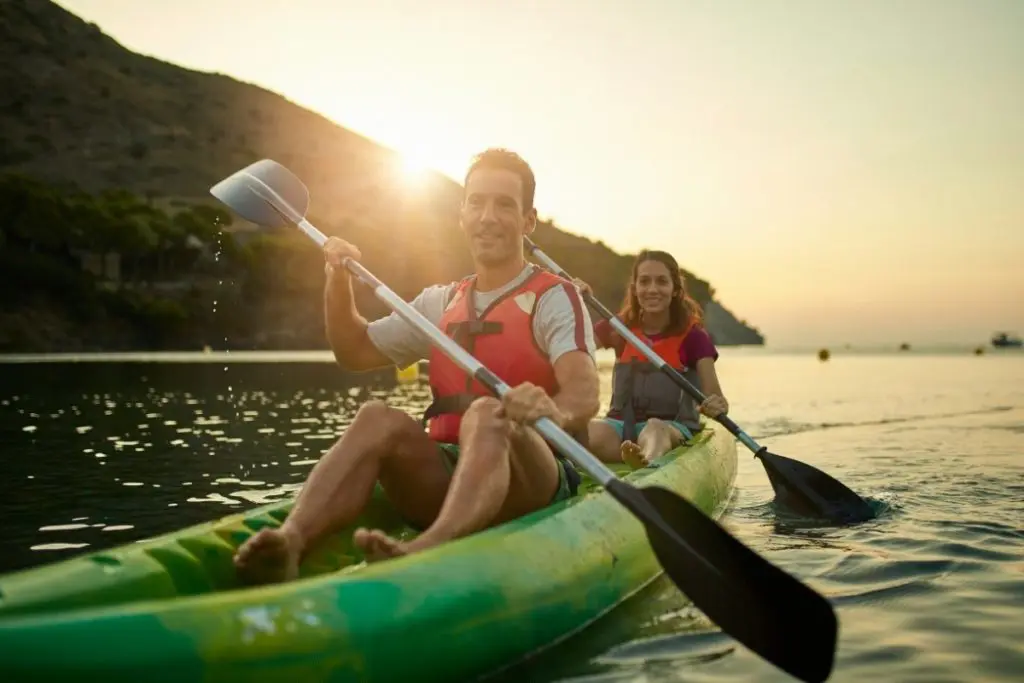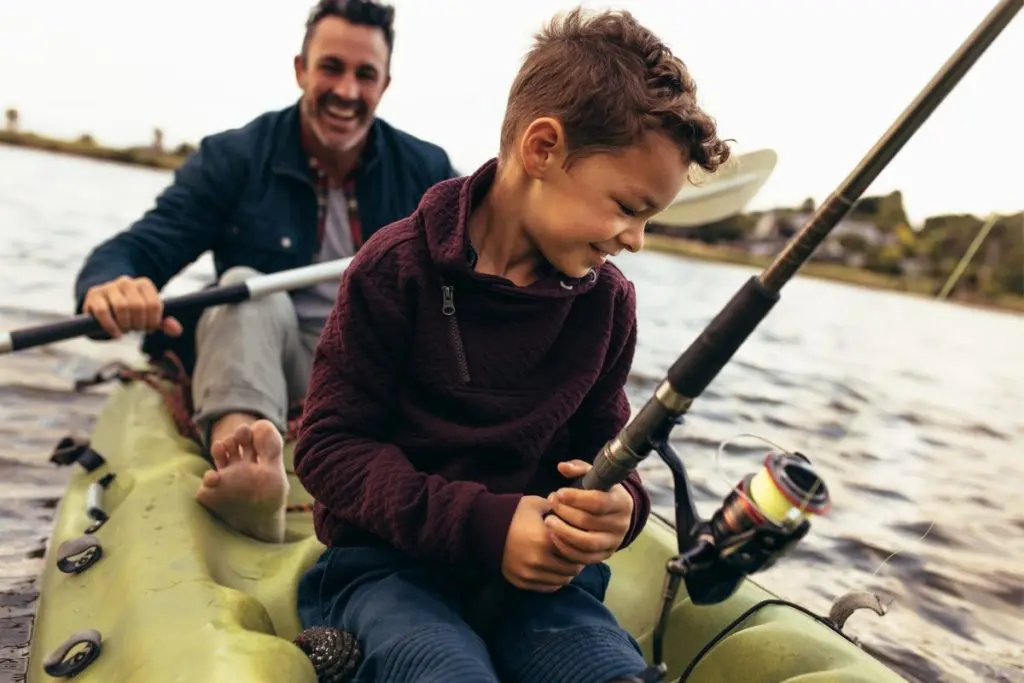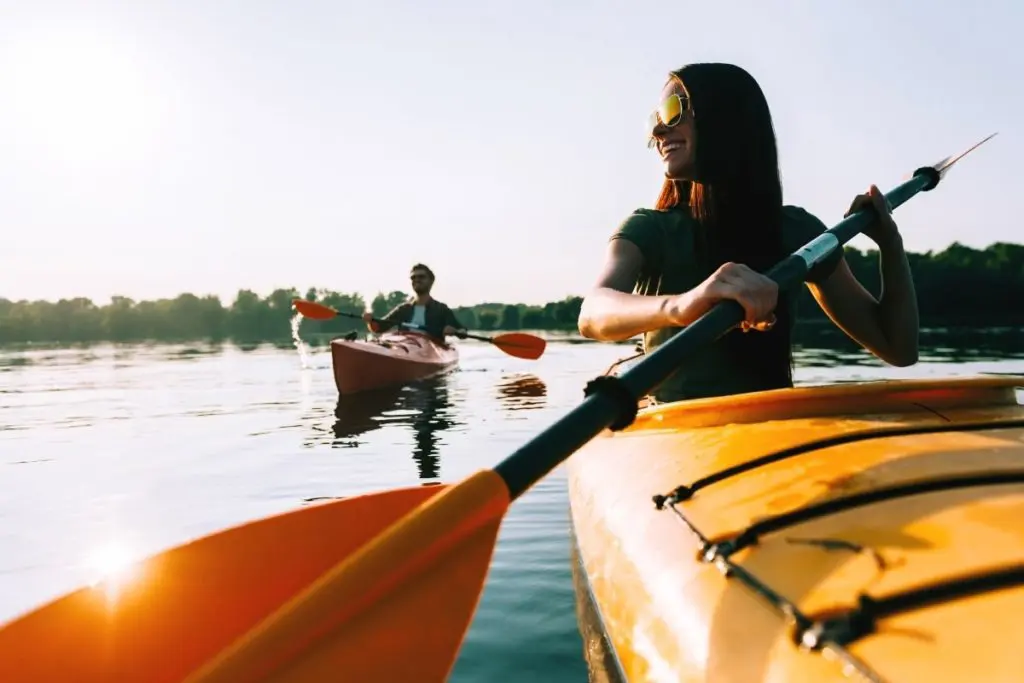When most people think of kayaks, they think of a small, single-seater, canoe-like boat that you use to float around a lake or calm river. But kayaks come in all different shapes and sizes. In fact, there are over a half-dozen types of kayaks available!
Whether you like casual kayaking, sea kayaking, whitewater kayaking, or even kayak fishing — there’s a vessel out there for you.
7 Types of Kayaks
These different types of kayaks are available as sit-in, sit-on-top, tandem, kid, and pedal-powered models.
1
Recreational Kayaks
This is the most common type of kayak. When you go to your local Walmart or Dick’s Sporting Goods and look at the kayaks they have on the shelves, you’re probably looking at recreational kayaks. Their design makes them perfect for that stereotypical image of kayaking we mentioned: floating out on the lake and quietly paddling down a calm river. They can handle light rapids and can reach decent speeds if you put enough muscle into it. That said, they aren’t meant to be used for anything strenuous.
2
Inflatable Kayaks
Inflatable kayaks are actually a subtype of recreational kayaks. As the name suggests, they use air to stay buoyant. Inflatables are lighter weight than hard kayaks, and can be deflated to store and travel compactly. They’re also significantly less expensive than traditional kayaks, meaning you can get more accessories and frills for your money. If you’re new to kayaking or are just interested in casual kayaking, then an inflatable kayak is perfect for you.
3
Sea Kayaks
Ocean waters are fraught with rolling swells and crashing waves, which can topple lesser kayaks. Sea kayaks are designed specifically to handle these kinds of turbulent conditions with extra-long noses and rears (totaling around 15 feet on average) and anti-tip technology. With all that extra length, they typically have a lot of extra on-board storage for you to bring all sorts of supplies and gear with you on the open ocean.

4
Whitewater Kayaks
Constructed for performance, whitewater kayaks are for advanced kayakers, thrill-seekers, and those of us looking for a challenge. Whitewater rapids are so named because of the water’s white appearance as it churns over rocks and around bends. These rapids move… well… rapidly, and whitewater kayaks are agile enough to make tight corners and go with the flow to avoid tipping over. They’re also made extra-durable, so they can take a couple hits against the rocks and keep going. Whitewater kayaks are usually smaller and easier to maneuver, with a broader base for stability in rough water.
5
Racing Kayaks
Longer and narrower than other kayaks, racing kayaks are built for speed. Their aerodynamic shape allows them to slice through the water with minimal wind resistance so you can beat out other racers to cross the finish lines. Single racing kayaks are referred to as K1s, while two-person kayaks are K2s, and four-person kayaks are K4s.
6
Fishing Kayaks
With their extra-wide construction and anti-tipping noses, fishing kayaks are perfect for reeling in the big ones. They make it possible to reach special fishing areas that larger vessels can’t get into, and they do it without scaring away the fish! Some are stable enough that more adventurous anglers can stand confidently while hauling in Moby Dick. Most fishing kayaks have extra on-board storage to hold all your fishing gear, and are often outfitted with fishing pole holders so you can relax until you get a bite.
7
Surf Kayaks
A variation of the sea kayak, surf kayaks are like a hybrid between a whitewater kayak and a racing kayak. These narrow boats are designed to catch the waves at high speeds, making them great for water-rescue units and lifeguards, as well as those who want to enjoy the surf without ending up underwater.
5 Main Categories of Kayaks

All types of kayaks come in one or more of these categories:
1. Sit-in Kayaks. When you think of a traditional kayak, you’re probably picturing a sit-in model. They look similar to canoes in that there’s a cockpit that the paddler sits inside. This can make it harder to get in and out of them, but you’re much less likely to get wet in a sit-in kayak. Sit-ins offer excellent stability, and less experienced kayakers generally find them more comfortable and secure than sit-on-top kayaks.
2. Sit-On-Top Kayaks. The counterpart to sit-in kayak is the sit-on-top kayak. Rather than sitting in a cockpit, the paddler(s) sits in a concave recess on top of the kayak, usually outfitted with a padded seat cushion and backrest. Sit-on-tops are much easier to get into and out of than sit-ins. But be prepared to get wet; there aren’t any cockpit walls to protect you. Where sit-in kayaks might have on-board storage for gear and snacks, sit-on-top kayaks are usually only outfitted with attachment points like D-rings for you to secure your dry bag or cooler.
3. Tandem Kayaks. Tandem simply means a two-person kayak. Both kayakers have to learn to work together and row synchronously to operate these, which may take some practice.
4. Kid Kayaks. Much less expensive than full-sized kayaks, kid kayaks have smaller cockpits for smaller bodies, and often come with built-in foam floaties to ensure little heads always stay above water. Kid kayaks are lightweight and easy to maneuver. However, they should only be used on calm rivers and lakes where there is minimal chance of capsizing.
5. Pedal-Powered Kayaks. Pedal-powered kayaks use foot pedals to propel forwards rather than paddling. You’ll get more endurance out of your legs than your arms, and you can reach greater speeds with less effort. Pedal kayaks are much more efficient for long distances and make sustained propulsion much easier to maintain. Most pedal kayaks have a rudder system that you adjust to control direction. Otherwise, you can move around hands-free, which makes pedal kayaks especially popular with fishermen.
What’s the Best Type of Kayak?
Now that we’ve seen the types of kayaks and their uses, what’s the best overall?
The recreational kayak category is a safe zone to stay in for any kayaker, regardless of paddling experience. They come in many different styles to suit your preference, and you can easily accessorize them to suit your needs. Some models have extra detachable seating so that you can bring along a budding kayak enthusiast, your children, or even your fur babies.
We especially recommend recreational kayaks for beginners and those who aren’t sure what they want to do yet. They’ll get you out on the water and kayaking with minimal prep — all you need is a paddle, and you can go out and tackle the local rivers and lakes.
While we know kayaks can easily break the bank in terms of price, don’t just look for the cheapest boat on the market. Taking on whitewater rapids in a basic inflatable recreation kayak is a recipe for disaster, or at the very least, capsizing! Budget kayaks and inflatables are great, but once you’ve got some experience under your belt, you’ll want to invest in a kayak built for your particular needs.
Further Reading






